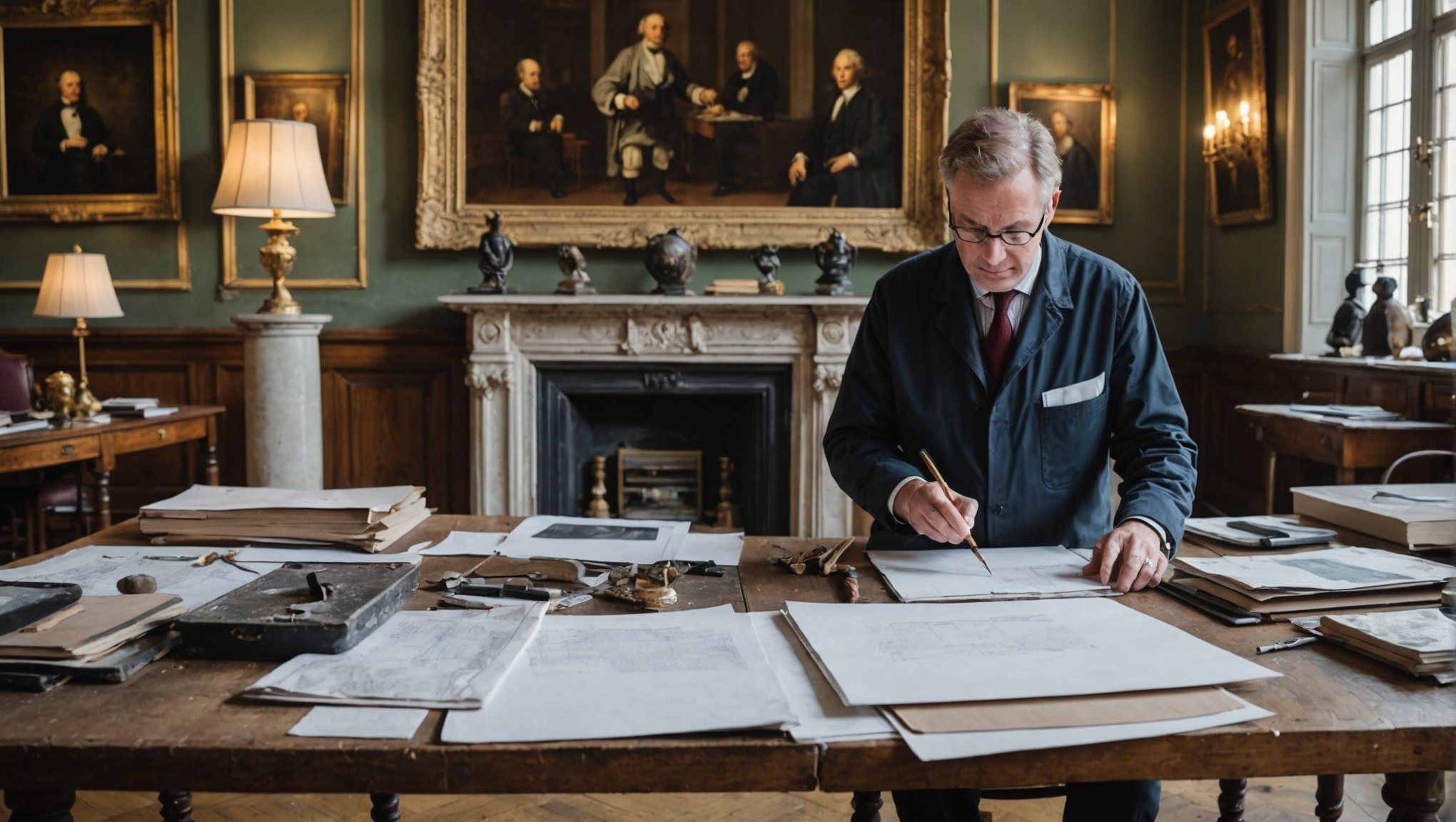For art restoration businesses in the UK, navigating conservation regulations is essential for ensuring the preservation of cultural heritage. Understanding legal requirements not only protects valuable artwork but also enhances professional credibility. This guide outlines practical guidelines that assist restoration specialists in complying with these regulations. By implementing these strategies, businesses can contribute to the safeguarding of art while fostering trust among clients and institutions alike. Discover how to elevate your practices and ensure compliance effectively.
Overview of UK Conservation Regulations
Understanding the UK conservation regulations is crucial for those involved in art restoration. These regulations have evolved over time, reflecting the nation's commitment to preserving cultural heritage. The historical context of these laws dates back to the 19th century when the first attempts to protect national treasures were made.
Have you seen this : Unlocking Brand Identity: The Power of Storytelling for UK Artisanal Food Businesses
Key Legislation
Several key pieces of legislation impact art restoration practices today. The National Heritage Act and the Planning (Listed Buildings and Conservation Areas) Act are among the most significant. These laws ensure that restoration efforts adhere to strict guidelines, maintaining the integrity and historical accuracy of artworks.
Importance of Compliance
For art restoration businesses, compliance with these regulations is not just a legal obligation but a mark of credibility. Failing to comply can lead to legal repercussions and damage to reputation. Here are some benefits of compliance:
Also to see : Strategies for UK Businesses to Boost Employee Well-being and Maximize Productivity
- Ensures high standards of restoration
- Protects the cultural significance of artworks
- Builds trust with clients and stakeholders
In conclusion, understanding and adhering to UK conservation regulations is essential for maintaining the quality and authenticity of restored art. This knowledge empowers businesses to make informed decisions, ensuring the preservation of cultural heritage for future generations.
Best Practices for Art Restoration
Implementing ethical and effective techniques is crucial for preserving art.
Ethical Considerations in Art Restoration
Art restoration best practices emphasize the importance of ethical considerations. Restorers must respect the original intentions of the artist while ensuring the artwork's longevity. This involves making reversible changes, avoiding over-restoration, and maintaining historical accuracy. As noted by a renowned conservator, "The goal is to preserve, not to alter."
Recommended Techniques and Materials
Selecting appropriate techniques and materials is vital. Conservation techniques should prioritize the stability and safety of the artwork. Commonly used materials include reversible adhesives and stable pigments. A bulleted list of recommended practices includes:
- Use of non-invasive methods
- Preference for natural, reversible materials
- Regular monitoring of environmental conditions
Importance of Documentation and Transparency
Documentation is a cornerstone of restoration ethics. Keeping detailed records of the restoration process ensures transparency and accountability. This practice not only supports future conservation efforts but also builds trust with stakeholders. Thorough documentation includes:
- Initial condition reports
- Detailed restoration logs
- Photographic evidence before and after treatment
Incorporating these art restoration best practices fosters a responsible approach to conservation, safeguarding cultural heritage for generations to come.
Regulatory Frameworks and Guidelines
Understanding the landscape of conservation regulations is essential for compliance.
Overview of Key Regulatory Bodies
In the UK, several regulatory frameworks and conservation guidelines govern art restoration. Key regulatory bodies include Historic England, the Arts Council England, and the National Trust. These organizations ensure that UK art laws are upheld, providing oversight and guidance for conservation efforts. They play a crucial role in maintaining the integrity of cultural heritage.
Historic England is responsible for advising on the conservation of historic sites, while the Arts Council England supports the arts sector with funding and resources. The National Trust safeguards historic places and landscapes, ensuring they are preserved for future generations.
| Regulatory Body | Role in Conservation |
|---|---|
| Historic England | Advises on conservation of historic sites |
| Arts Council England | Supports arts sector with funding/resources |
| National Trust | Preserves historic places/landscapes |
These regulatory bodies provide essential guidelines that art restorers must follow. Compliance with these conservation guidelines not only ensures legal adherence but also upholds the highest standards of restoration. Engaging with these organizations and understanding their roles helps art restorers navigate the complex landscape of UK art laws effectively.
Case Studies of Successful Compliance
Exploring real-world examples of effective art restoration compliance.
Notable Art Restoration Projects in the UK
Art restoration case studies offer valuable insights into the practical application of compliance. One such project involved the restoration of a historic mural in a London church. This success story highlighted the importance of adhering to UK conservation regulations, ensuring historical accuracy and ethical standards.
Lessons Learned from Compliance Challenges
Challenges often arise during restoration, but overcoming them strengthens a business's reputation. A renowned conservator noted, "Compliance is not just about following rules; it's about respecting the art." This mindset was crucial in a project where restorer's faced difficulties with material selection. By consulting regulatory bodies, they ensured their methods aligned with conservation guidelines.
Impact on Business Reputation
Successful compliance significantly enhances a business's credibility. For example, a gallery in Manchester saw increased client trust after a well-executed restoration. This compliance example demonstrated how following regulatory frameworks can lead to positive outcomes.
- Increased client trust
- Enhanced business reputation
- Greater opportunity for future projects
These art restoration case studies underscore the benefits of compliance, illustrating how adherence to guidelines not only preserves cultural heritage but also fosters business growth. Engaging with these examples encourages restorers to prioritize compliance in their practices.
Training and Certification for Professionals
Enhancing skills through structured learning and accreditation.
Overview of Available Training Programs and Certifications
In the realm of art restoration, obtaining professional certification is essential for credibility and skill enhancement. Various programs cater to different aspects of art restoration training, offering both theoretical knowledge and practical experience. Institutions like the Courtauld Institute of Art and West Dean College provide comprehensive courses. These programs cover topics such as material science, ethical considerations, and advanced restoration techniques.
Importance of Ongoing Education in Conservation Practices
Continuous education is crucial for staying updated with the latest conservation practices. As technology and methodologies evolve, professionals must adapt to new challenges in the field. Engaging in ongoing art restoration training ensures that restorers maintain high standards and effectively preserve cultural heritage. A leading conservator emphasizes, "Continuous learning is the backbone of effective restoration."
Role of Professional Organizations in Skill Development
Professional organizations play a pivotal role in skill development by offering resources and networking opportunities. Bodies like the Institute of Conservation (ICON) provide workshops and seminars. These platforms facilitate knowledge exchange and help practitioners achieve professional certification.
- Access to industry experts
- Networking opportunities
- Workshops and seminars
Engaging with these organizations enhances art restoration training, allowing professionals to refine their skills and advance their careers.
Maintaining Ethical Standards
Ensuring integrity and responsibility in art restoration practices.
Defining Ethical Standards in Art Restoration
Ethical standards in restoration are essential to uphold the integrity of cultural heritage. These standards dictate that restorers respect the original artist's intent and maintain professional integrity. Conservation ethics require that all interventions are reversible and transparent, ensuring that future generations can appreciate the artwork in its authentic form.
Strategies for Ensuring Ethical Practices
Art restoration businesses can implement several strategies to uphold ethical standards. Regular training on conservation ethics is crucial, ensuring that staff remain informed about best practices. Establishing a clear code of conduct helps maintain professional integrity across all projects. Collaborating with established conservation bodies can also guide ethical decision-making.
- Regular ethics training
- Clear code of conduct
- Collaboration with conservation bodies
Consequences of Unethical Practices
Failing to adhere to ethical standards in restoration can lead to significant consequences. Unethical practices may result in irreversible damage to the artwork, tarnishing a business's reputation. Moreover, it can lead to legal repercussions and loss of client trust. A respected conservator warns, "Ignoring conservation ethics is akin to erasing history." Maintaining professional integrity is therefore not just a choice but a necessity in the restoration field.
Resources and Further Reading
Expanding knowledge through comprehensive resources and professional networks.
Relevant Legislation and Guidelines
Understanding art conservation resources is essential for professionals seeking to enhance their knowledge. Key legislation includes the National Heritage Act and the Planning (Listed Buildings and Conservation Areas) Act. These guidelines provide a legal framework for art restoration, ensuring compliance and ethical practices. Familiarity with these laws is crucial for maintaining high standards in the field.
Recommended Books and Articles
Diving into further reading can significantly bolster one's understanding of art restoration. Notable books such as "The Conservation of Artifacts" by Sharon T. Smith and articles like "Ethical Practices in Art Restoration" offer in-depth insights. These texts cover a range of topics, from materials science to ethical considerations, serving as invaluable art conservation resources.
Professional Organizations and Networks
Engagement with professional organizations is vital for continuous learning and support. Institutions like the Institute of Conservation (ICON) and the Courtauld Institute of Art offer workshops and seminars. These platforms provide networking opportunities and access to industry experts, fostering a community of practice.
- Institute of Conservation (ICON)
- Courtauld Institute of Art
- West Dean College
By utilizing these art conservation resources, professionals can stay informed and connected, ensuring their practices remain ethical and effective.






